Class 12-science NCERT Solutions Economics Chapter 2 - Indian Economy 1950-1990
Indian Economy 1950-1990 Exercise 34
Solution 1
A plan specifies the set of objectives to be achieved within a specified period of time. It shows the means and ways to allocate available resources in an optimum manner in different developmental activities of a country.
The duration of plans in India is of five years and is called a five year plan. The five year plan has been adopted from the former Soviet Union, the pioneer in economic planning. The first five year plan was introduced in April 1951.
Solution 2
India opted for planning because of the following reasons:
- At the time of independence, the unemployment rate was very high and the Per Capita Income and Gross Domestic Product were very low.
- The industrial sector was not developed and Indian handicrafts were ruined by the colonial government.
- The agricultural sector was in a backward and stagnant stage.
Thus, India opted for planning to fight against backwardness and to start the process of economic development. In this regard, India opted for socialism as Indian leaders were motivated by the success of Soviet Union's planning. Indian planners were clear about the fact that there was shortage of private capital and lack of incentive for the private sector to function in the social sector. So, it was planned to adopt a socialist idea with an emphasis on the public sector along with encouragement of contribution from the private sector in non-priority industries through a democratic set up. The comprehensive planning for the country was made by the government with specific objectives of five year plans.
Hence, planning was initiated to make the public sector to work within the basic economic framework, and private sector firms were encouraged towards economic growth.

Solution 3
In India, there are limited resources to fulfil unlimited wants. So, it was very important for planners to have specific goals for a specific period. Planners had to determine specific and general goals to allocate scarce resources in an optimum manner. Goals are the ultimate targets to ensure successful plans. The goals of five year plans were growth, modernisation, equity and self-reliance. All plans have specific targets so that work can be done more efficiently and is accomplished on a priority within the specific period of time. If a plan has no specific goal, then the plan would be directionless and will lead to wastage of resources in an economy. Hence, plans should specify goals to be achieved within a definite period.
Solution 4
High yielding variety (HYV) seeds are useful in increasing the production of food grains. These seeds are also known as miracle seeds. The use of HYV seeds requires regular supply of water, use of pesticides and fertilisers. Hence, farmers require proper irrigation facilities and necessary financial support to consume fertilisers and pesticides to obtain the benefit of HYV seeds.
Solution 5
Marketable surplus is the difference between the total agricultural output produced by farmers and the part of the total agricultural output used for their self-consumption, i.e. the part of agricultural production which is sold in the market by farmers.
Solution 6
Need for land reforms:
- Land revenue system: The colonial government in India introduced various systems of land settlement. The zamindari system was one such land settlement system. Under this system, zamindars were owners of the land and collected rent from cultivators without any contribution to improvement of the farm.
- Low productivity: The Indian agricultural sector was deprived of irrigation facilities and technology advancement. As a result, the production of the agricultural sector was solely dependent on the monsoon. This created an adverse situation for farmers and led to a low level of agricultural productivity.
- Landholding size: Due to sub-division and fragmentation of agricultural holding, the adoption of advanced technology in the agricultural sector was very difficult.
Types of land reforms implemented in the agricultural sector:
- Abolition of intermediaries: The idea behind the abolition of intermediaries was that ownership of land will motivate cultivators to make improvement in agricultural production with lot of efforts and investment. Nearly, 200 lakh tenants came into direct contact with the state government; about 173 million acres of land were taken away from zamindars and given to landless cultivators. Thus, the ownership of land motivated them to make profit from the increased level of agricultural production.
- Land ceiling: Under the land ceiling policy, a limit was set for individuals to own a maximum size of land. This policy helped to reduce inequality in the agricultural sector. By fixing a ceiling, surplus land can be redistributed among landless cultivators and small farmers. On the other hand, the minimum limit will prevent them from holding below the minimum size of land.
- Landholding consolidation: In 1921, a law was introduced to prevent the segmentation and sub-division of land holding. This was first initiated in Punjab by converting various small parts of land holders into one plot. At the beginning, there were few voluntary cooperative societies for consolidation of land holdings and later compulsory legislation was passed for consolidation of land holdings in different states. This helped to bring the scattered and fragmented land into one big piece and helped farmers to use the same for productive purposes.
- Regulation of rent: All the states enacted laws to determine the rent payable by tenant cultivators. However, this rent structure varied between 30% and 40% of produce in each state.
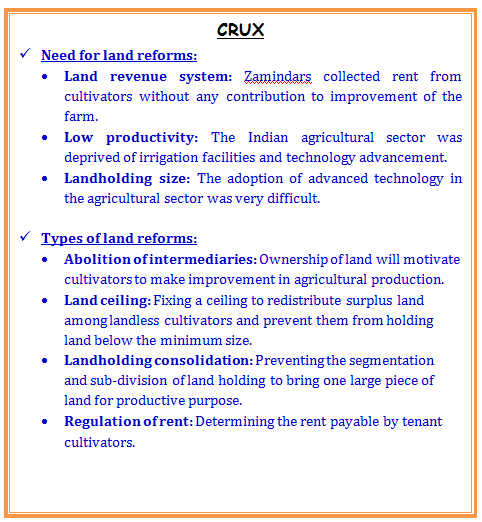
Solution 7
Green Revolution refers to an increase in the production of food grains due to the use of high yielding variety (HYV) seeds, use of fertilisers, pesticides and irrigation facilities.
Reasons for implementation of Green Revolution:
- At the time of independence, a large chunk of farmers were dependent on the monsoon due to which they faced innumerable problems in farming activities.
- The technology and machinery used in farming were obsolete which resulted in low agricultural productivity.
- Famines affected agricultural productivity in the 1940s.
- Indian agriculture suffered from low productivity of food grains as more emphasis was given to cash crops during the colonial rule. This resulted in the shortage of food grains in India.
- Indian farmers were dependent on landlords and rural money lenders to meet their credit requirements. Landlords and lenders exploited farmers.
The Green Revolution ensured food security to the Indian population. The motive behind implementing the Green Revolution was to increase agricultural productivity. This was possible because nearly 75% of the country's population was engaged in this sector. This resulted in a significant increase in the production of food grains.
Benefits to farmers:
- Availability of inputs: It enabled farmers to use HYV seeds, pesticides, fertilisers and well-developed agricultural methods in areas where the supply of water was regular.
- Scientific rotation of crops: It allowed the farmers to harvest more than two crops in a year through the initiation of short-term HYV seeds for major crops.
- Credit facility: It provided farmers with sufficient credit facilities and package of inputs before the sowing season through government programmes.
- Minimum support prices: It ensured farmers with reasonable prices for their produce through minimum support prices and prevented income fluctuations.
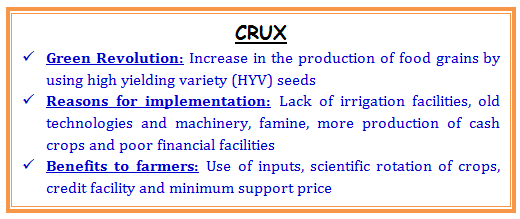
Solution 8
One of the important objectives of planning is to get stable growth with equity in the economy. Growth refers to an increase in the level of national income over a period of time and equity refers to equitable distribution of the national income.
For every nation, it is very important to have growth along with equity. If there is only growth (without equity) in the economy, then it means that everyone is not enjoying the benefit of growth. In this regard, planners have to ensure that the prosperity of economic growth should reach all the people. Every individual should be able to fulfil his/her basic needs of food, house, education and healthcare.
So, the government should ensure appropriate allocation of wealth among the people to reduce economic inequality in the economy. Therefore, 'growth with equity' is a more rational and desirable objective of planning for a nation.
Solution 9
Modernisation is the use of advanced technology in the production of goods and services so that productivity can be increased. It does not have any negative impact on employment generation. In fact, modernisation and employment generation go hand in hand. For example, the use of modern technology in the factory can lead to an increase in the level of output. Similarly, a farmer can produce more by using HYV seeds rather than using conventional ones. However, it may happen that some people do not get jobs because of modernisation. In the long run, output increases due to modernisation leading to an increase in income of the people in society. This further increases the demand for goods and services in the market. Hence, the production of goods will be increased to meet the demand of people resulting in generation of employment opportunities in the economy. Thus, modernisation as a planning objective does not create contradiction in the light of employment generation.
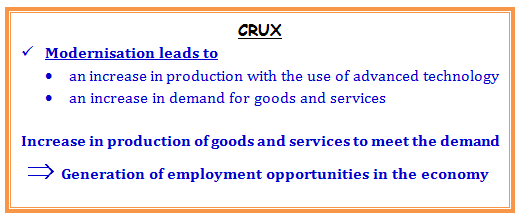
Solution 10
Self-reliance is reducing or eliminating the dependency on other nations, i.e. preventing import of goods from other nations and encouraging producing those goods domestically. It is essential for a developing nation like India to follow self-reliance as a planning objective. This is because at the time of independence, India was completely dependent on foreign countries for food, technology and capital goods which affected India's sovereignty adversely. This led to foreign government interference in Indian internal policies. Hence, India adopted the following ways to became self-reliant:
- Maintained self-sufficient food grains and increased the share of the industrial sector in gross domestic product.
- The growth of domestic production led to a fall in foreign aid and dependency on import of goods.
Therefore, there was strong emphasis on self-reliance in the first seven five year plans.
Solution 11
Sectoral composition of an economy is the contribution of sectors such as the agricultural sector, service sector and industrial sector to the GDP of an economy.
Yes, it is necessary that the service sector should contribute maximum to the GDP of an economy. When an economy grows, there exists a situation called structural transformation. This implies that the economy's dependence on the agricultural sector will decrease to the minimum level and the share of the industrial and service sectors in the total GDP will increase over the years. The growth in the performance of the service sector with higher contribution to the total GDP is an indication of economic development.
Solution 12
Public sector enterprises are owned and managed by the government. At the time of independence, the state of the Indian economy was backward and underdeveloped. During the planning period, the public sector was given a leading role in industrial development because of the following reasons:
- Lack of capital: Private entrepreneurs lacked capital for setting industries as a huge amount was required. Thus, the government took the responsibility of developing industries in the economy.
- Lack of incentive: The Indian market was comparatively small which discouraged Indian industrialists to invest in major projects (even though they had sufficient capital to invest). Thus, the government promoted the industrial sector.
- Development of India on socialist base: Indian planners wanted to develop the Indian economy on a socialist base, so they focused on government-funded major projects.
- Social welfare: In India, there were certain projects in which the profit margin was negligible. Thus, the private sector was not interested in such projects, and it was only the public sector which could bring the balanced regional growth with the establishment of government units in the backward areas. This move could increase the employment and income of the people.
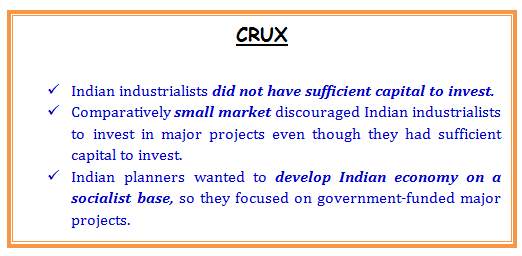
Solution 13
Green Revolution is sustained increase in the production of food grains. This revolution was made possible by using high yielding variety (HYV) seeds. Farmers were able to produce surplus food grains, i.e. more than the required food grains. This surplus was purchased by the government to maintain the buffer stock. This buffer stock was used by the government in times of shortage. Hence, the Green Revolution enabled the government to procure sufficient food grains to build its stocks which could be used during times of shortage.
Solution 14
It has been rightly said that subsidies encourage farmers to use new technology but they are also a huge burden on government finances.
Points for usefulness of subsidies:
- Subsidies help in encouraging farmers to use new and innovative technology.
- In India, more than 50% of the farmers are very poor and cannot afford new technology in their farming activity. In this regard, the government can help them by providing subsidies.
- The abolishment of subsidy will violate the goal of equity because it raises differences between poor and rich farmers in India.
- The application of new technology in farming will increase the total output of agricultural products in developing nations.
However, the subsidy is helpful for farmers to cope with advanced technology and higher productivity level. Government planning is required to target farmers who really need financial assistance and avoid the wastage of resources which increase the burden of the government.
Points against subsidies:
- Some economists are of the view that once technology is widely accepted, the government should stop providing goods at subsidised rates.
- Subsidies are provided to benefit farmers, but it has been observed that the fertiliser industry has benefited more than farmers.
- Also, farmers from prosperous regions benefited from subsidies more than farmers from poor areas.
Hence, it has been argued that the fertiliser subsidy should not be continued as it failed to serve the target group. However, other economists were in favour of continuing the subsidy as farming is the most important business in India.
Solution 15
Implementation of the Green Revolution in the agricultural sector resulted in a significant increase in agricultural output, but the same output could have been increased with fewer workers in the agricultural sector. India was not able to attain structural transformation related to growth and development of an economy.
The number of people dependent on agriculture was 67.5% in 1950, and it has declined to only 64.9% in 1990. The proportion of GDP contributed by the agricultural sector had fallen drastically between 1950 and 1990. A remarkable fact about India is that while there has been a change in the share of three sectors in GDP, a similar shift has not taken place in employment. During 1950-1990, the service sector and industry sector were unable to absorb excess agricultural workers. This was the main reason that 65% of the Indian population continued to engage in the agricultural sector till 1990. This led to a disguised unemployment situation in agriculture.
Solution 16
Yes, it is true that although the public sector is essential for industries, many public sector undertakings incur huge losses and are a drain on the economy's resources. However, the public sector plays an important role in improving social welfare and economic development of India. The usefulness of the public sector can be better understood through the following points:
- Creation of a strong industrial base: After independence, there were gaps in heavy industries; the public sector assisted to bridge the structural gap between demand and supply and created a strong industrial base in India. They achieved tremendous growth in defence industries, iron and steel, engineering and electrical, petroleum and natural gas. Because heavy industries required huge investment and incurred no profit in the short period, the private sector was unwilling to take part in these fields of production. Therefore, the public sector undertakings created a strong industrial base by developing heavy and capital intensive technique-based industries in India.
- Long-run gestation projects: The private sector firms were reluctant to invest in long period projects as it was economically infeasible. Hence, the public sector made investments in long-run projects.
- Improving social welfare: Public sector undertakings produced goods and services in the fields of health, education and infrastructural facilities such as hospitals, roads, highways, schools and electricity to improve the welfare of the nation.
- Reducing income inequality: Since the government owned and regulated public undertakings, the profit earned by them were spent on special welfare programmes and certain amount of profit for industrial development. The government helped the poor to attain benefit from their regulation and thus promoted equal distribution of income and wealth in the economy.
- Employment generation: The public sector created substantial employment opportunities in a situation of the twin problems of poverty and unemployment.
After independence, Indian planners had decided to focus on social development along with economic development. It was assumed that if the private sector was allowed to invest in all the sectors, then it may hamper India's socialist growth pattern. Hence, we can conclude that public sector undertakings significantly contributed to the growth and development of the Indian industrial sector.
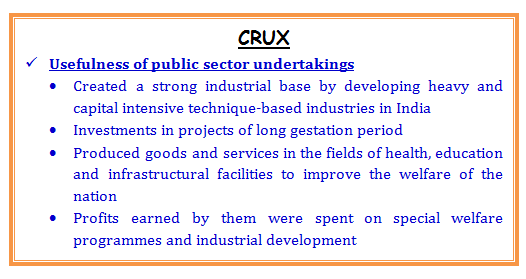
Indian Economy 1950-1990 Exercise 35
Solution 17
Import substitution is considered an inward looking trade policy. It aimed to discourage the imports of those goods and services which can be produced domestically. The strategy of import substitution was not only to protect domestic producers from foreign competitors but also to decrease the dependency on foreign goods and services.
In the policy of import substitution, domestic producers were protected in two ways, i.e. by imposing tariffs and quotas on imported goods. Tariffs are taxes levied on imported goods. Quotas are the specified quantity which can be imported from foreign countries.
Thus, domestic firms were protected from foreign competition with the help of import substitution policy.
Solution 18
The Industrial Policy Resolution (IPR) 1956 emphasised on the expansion of the public sector, development of heavy and machine building industries, ownership and control of the private sector and establishing the cooperative sector.
IPR 1956 classified industries into 3 categories:
Category I: 17 industries exclusive to the public sector
Category II: 12 industries progressively state owned
Category III: Industries not included in category I and II are given to the private sector which are owned and controlled by the government
The private sector was regulated under IPR 1956 to promote industrialisation in backward regions for reducing regional inequality. The following steps were taken:
- They have to obtain a licence to make an entry in the economy.
- Strict licensing policy was introduced to establish industry in urban areas, whereas easier licensing was provided to establish new industries in backward regions.
- Promoting industrialisation in backward regions was the main motive behind IPR 1956. Concession in the form of taxation was given for units which were established in backward regions.
- Obtaining licences to establish a new unit has been made mandatory for existing firms also.
In this way, the private sector was regulated to reduce regional inequality and promote industrialisation.
Solution 19
|
1. Prime Minister |
|
|
2. Gross domestic product |
|
|
3. Quota |
|
|
4. Land reforms |
|
|
5. HYV seeds |
|
|
6. Subsidy |
|

